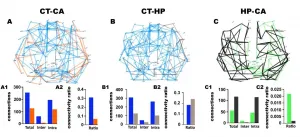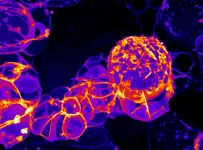INFORMATION:
Article Title: Prevalence and outcomes of co-infection and superinfection with SARS-CoV-2 and other pathogens: A systematic review and meta-analysis
Funding: NS received research support for this work from the National Institute of Allergy and Infectious Diseases of the National Institutes of Health under Award Number DP2AI144244. The content is solely the responsibility of the authors and does not necessarily represent the official views of the National Institutes of Health. The funding agency did not play any role in the study's design, data collection, analysis, decision to publish or preparation of the manuscript.
Competing Interests: The authors have declared that no competing interests exist.
Article URL: https://journals.plos.org/plosone/article?id=10.1371/journal.pone.0251170
Almost 1 in 4 COVID-19 patients have another infection simultaneously or subsequently
2021-05-19
(Press-News.org) Almost 1 in 4 COVID-19 patients have another bacterial, viral or fungal infection simultaneously or subsequently, with such patients experiencing worse disease outcomes.
ELSE PRESS RELEASES FROM THIS DATE:
Maintaining self-control -- The careful balance of the immune system
2021-05-19
Tsukuba, Japan - Autoimmune diseases occur when an individual's immune system fights their own body as if it was a foreign invader. However, in healthy people, these responses are prevented by a process known as immune tolerance. Many complex biological mechanisms maintain the necessary balance between immune activation and suppression to ensure immune tolerance does not prevent the body from effectively fighting pathogens.
In a new study published in PNAS, a group of researchers from the University of Tsukuba uncovered how the relationship between two receptors called DNAM-1 and TIGIT helps preserve the balance for optimal immune function. Both of these molecules have previously been studied ...
New study identifies plasticity disparities between patients with brain malformation
2021-05-19
Recently published in the scientific journal Brain Communications, a new study distinguished structural patterns between individuals with corpus callosum dysgenesis (CCD), a congenital condition that consists of the absence or incomplete development in the connecting structure between the two brain hemispheres. The research was carried out by the D'Or Institute for Research and Education (IDOR), the University of Pittsburgh, Oswaldo Cruz Foundation (Fiocruz), and the Federal University of Rio de Janeiro (UFRJ).
Investigating CCD is an arduous task for doctors and neuroscientists. There aren't many patients available for research, and the anatomical variability of brains with CCD creates a broad ...
Childhood disadvantage affects brain connectivity
2021-05-19
Philadelphia, May 18, 2021 - Many socioeconomically disadvantaged children face poor cognitive and mental health outcomes, and researchers are working to determine the specific factors that link childhood conditions to those poor outcomes, including how they might shape brain circuitry. In a new study, researchers have examined how "neighborhood disadvantage" can affect the developing brain, including the brain's connectivity between regions.
The study appears in Biological Psychiatry: Cognitive Neuroscience and Neuroimaging, published by Elsevier.
Sarah Whittle, PhD, and Divyangana Rakesh, lead authors of the study, studied existing brain scans from 7,618 children aged 9-10 collected as part of the Adolescent Brain Cognitive Development ...
Oregon researchers find cell division machinery that makes brain cells
2021-05-19
EUGENE, Ore. -- May 19, 2021 -- High-resolution imaging of fruit flies at the University of Oregon has captured mechanical motions that stem cells use to make neurons, the cells that make up the brain.
These motions coordinate cell division with differentiation, where newly born cells become neurons. Differentiation is essential for building the brain circuitry in complex organisms that underlies human cognition and emotions, said Ken Prehoda, a professor in the UO's Department of Chemistry and Biochemistry.
Prehoda was principal investigator of a project published online May 18 in the journal ...
New insights into androgen's action could boost battle against prostate cancer
2021-05-19
Researchers at UVA Cancer Center have unveiled important new insights into how hormones known as androgens act on our cells - and the discovery could boost efforts to develop better treatments for prostate, ovarian and breast cancers.
The findings shed light on how androgens interact with their receptors inside cells to affect gene activity. This process is important in both healthy cells and certain cancers. Hormone therapy for prostate cancer, for example, aims to reduce the amount of androgen in the body, or to stop it from fueling the cancer cells. However, ...
Wireless and battery-free spintronic energy harvester
2021-05-19
Researchers at the National University of Singapore (NUS) and Tohoku University have demonstrated that an array of electrically connected spintronic devices can harvest a 2.4 GHz wireless signal, which can be used to power and charge small electronic devices and sensors.
The researchers from NUS and Tohoku University have successfully synchronized the four electrically connected magnetic tunnel junction (MTJ), for the signal transmission at 2.4 GHz. Furthermore, the eight MTJs array was integrated with the conventional battery-free electronics to harvest a wireless signal of 2.4 GHz to a DC signal, which is used to power light emitting ...
Scientists take a bite out of solar efficiency challenge with sandwich model
2021-05-19
In a world hungry for cheaper, more efficient renewable energy, Australian researchers have served up a treat.
Work led by the ARC Centre of Excellence in Exciton Science has shown that the two-dimensional (2D) thin films used in some perovskite solar cells closely resemble a sandwich. Perovskite is an exciting material at the forefront of solar energy research and design.
Previously, scientists thought these 2D perovskite films had a 'gradient' structure, in which certain components were found deep in the material, with other complementary elements only located nearer to the surface, like topping on a cracker.
However, in a paper published ...
'No level of smoke exposure is safe'
2021-05-19
Nearly a quarter of pregnant women say they've been around secondhand smoke - in their homes, at work, around a friend or relative - which, according to new research, is linked to epigenetic changes - meaning changes to how genes are regulated rather than changes to the genetic code itself - in babies that could raise the risk of developmental disorders and cancer.
The study, published today in Environmental Health Perspectives by researchers at Virginia Commonwealth University Massey Cancer Center, is the first to connect secondhand smoke during pregnancy with epigenetic modifications to disease-related genes, measured at birth, which supports the idea that many adult ...
Children's sleep and adenotonsillectomy
2021-05-19
While a pint-sized snorer may seem adorable tucked up in bed, studies shows that children with sleep disordered breathing are likely to show aggressive and hyperactive behaviours during the day.
The recommended treatment is an adenotonsillectomy - the removal of adenoid and tonsils - not only to fix the snore, but also the behaviour.
Yet according to new research from the University of South Australia, while the surgery can cure a child's snoring it doesn't change their behaviour, despite common misconceptions by parents and doctors alike.
Conducted in partnership with the University ...
Same nerve cell -- Different influence on food intake
2021-05-19
The nerve cells, also called neurons, in our brain control all the basic processes of our body. For this reason, there are different types of neurons distributed over specific regions of the brain. Researchers at the Max Planck Institute for Metabolic Research and the CECAD Cluster of Excellence in Aging Research of the University of Cologne have developed an approach that allows them to show that neurons that are supposedly the same are actually very different: they not only sense different hormones for the body's energy state, but also have a different influence on food intake. This can have a direct effect on our metabolism, for example by differentially restraining our appetite.
The brain processes our sensory perceptions, controls our behaviour and stores ...







